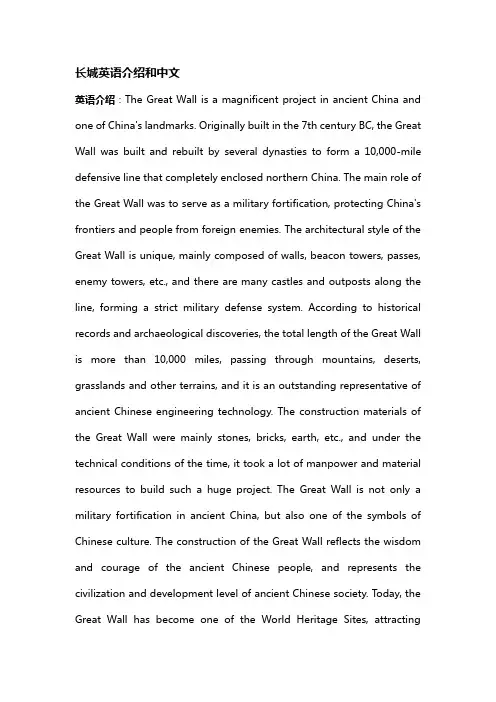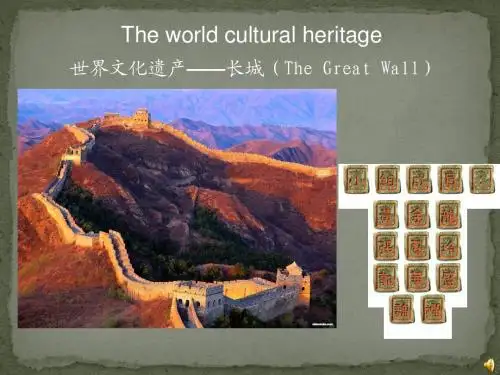长城的英文介绍.ppt
- 格式:ppt
- 大小:569.50 KB
- 文档页数:9

长城英语介绍和中文英语介绍:The Great Wall is a magnificent project in ancient China and one of China's landmarks. Originally built in the 7th century BC, the Great Wall was built and rebuilt by several dynasties to form a 10,000-mile defensive line that completely enclosed northern China. The main role of the Great Wall was to serve as a military fortification, protecting China's frontiers and people from foreign enemies. The architectural style of the Great Wall is unique, mainly composed of walls, beacon towers, passes, enemy towers, etc., and there are many castles and outposts along the line, forming a strict military defense system. According to historical records and archaeological discoveries, the total length of the Great Wall is more than 10,000 miles, passing through mountains, deserts, grasslands and other terrains, and it is an outstanding representative of ancient Chinese engineering technology. The construction materials of the Great Wall were mainly stones, bricks, earth, etc., and under the technical conditions of the time, it took a lot of manpower and material resources to build such a huge project. The Great Wall is not only a military fortification in ancient China, but also one of the symbols of Chinese culture. The construction of the Great Wall reflects the wisdom and courage of the ancient Chinese people, and represents the civilization and development level of ancient Chinese society. Today, the Great Wall has become one of the World Heritage Sites, attractingcountless tourists to visit and explore. In short, the Great Wall is one of the important representatives of ancient Chinese culture and one of the important symbols of Chinese culture. It is an outstanding representative of ancient Chinese engineering technology and one of the world's cultural heritages.长城(The Great Wall)是中国古代的一项宏伟工程,也是中国的标志性建筑之一。










介绍长城的简介英文版The Great Wall of China is one of the most iconic landmarks in the world and is widely regarded as one of the greatest architectural achievements in history. Stretching over 13,000 miles, the Great Wall was constructed over the course of several centuries and has stood as a symbol of China's strength and resilience.The construction of the Great Wall began as early as the 7th century BC, but the majority of the wall that stands today was built during the Ming Dynasty (1368-1644). The wall was originally built as a series of separate fortifications to protect against invading forces from the north, primarily the Mongols and other nomadic tribes. Over time, these separate fortifications were connected to form one continuous structure, creating the Great Wall that we are familiar with today.The wall itself is made of a variety of materials, including stone, brick, and packed earth. In some sections,the wall reaches heights of over 25 feet and is as wide as 30 feet, making it an imposing barrier for any would-be invaders. In addition to the wall itself, watchtowers, barracks, and other defensive structures were built along its length to enhance its defensive capabilities.While the primary function of the Great Wall was toprotect against invasion, it also served as a means of controlling trade and immigration. The wall was patrolled by guards and soldiers, and it had a series of signal towersthat could be used to communicate and coordinate defenses in the event of an attack. The wall also served as a symbol ofthe power and authority of the Chinese state, as well as a testament to the engineering and organizational skills of the people who built it.Today, the Great Wall is one of the most popular tourist attractions in the world, drawing millions of visitors each year. While some sections of the wall have fallen into disrepair, many parts have been restored and are open to the public. Visitors can walk along the wall, admire the stunning scenery, and gain a greater appreciation for the immense scale and historical significance of this remarkable structure.In conclusion, the Great Wall of China is a testament to the ingenuity and determination of the Chinese people. Its vast scale and enduring legacy continue to inspire awe and admiration from people around the world.。